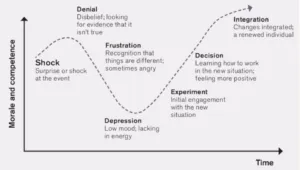Change: it’s the only constant in our dynamic world of work. Yet, it’s frequently met with apprehension rather than excitement. How we, as leaders, navigate and guide our teams through the shifting sands can significantly impact whether we thrive or survive. This enhanced blog post integrates actionable strategies with an understanding of the emotional journey of change, empowering you to lead confidently amidst uncertainty. Let’s transform apprehension into actionable insight, shall we?
Understanding The Emotional Journey Of Change
Change, whether chosen or imposed, initiates a complex emotional journey. When change happens to us, we traverse through seven stages: Shock, Denial, Frustration, Depression, Experiment, Decision, and Integration. It’s crucial to process each stage fully; skipping or rushing can hinder our ability to move forward effectively.
Conversely, when we initiate change, we embark on a path of Uninformed Optimism, followed by Realized Pessimism, the Valley of Despair, Realized Optimism, and finally, Success. At any point along this journey, we can fall prey to our subconscious desire to find comfort and move away from the challenges that change can bring. We accomplish this by giving up too early and finding reasons to quit on the challenging stuff. Although difficult, we can push through on this journey, which is a testament to our resilience and capacity for growth. Recognizing these emotional landscapes is the first step in harnessing change to our advantage.


Acknowledge The Winds Of Change
Acknowledgment is powerful. Recognizing change and its impact on your team sets the stage for meaningful leadership. It’s about seeing the change and understanding its breadth and depth. This acknowledgment forms the foundation of our journey through change. Communicating what you see and feel can provide clarity and purpose for the rest of your team.
- Foster a Culture of Open Communication: Clear, open communication serves as the lighthouse through foggy seas. It’s not just about communicating what’s going on with you; it’s also about creating an environment that allows others to share their thoughts, feelings, and aspirations. A culture where every voice is heard and valued not only eases anxieties but can also reveal innovative solutions to emerging challenges.
- Lead with Empathy and Support: Empathy is the cornerstone of effective leadership, particularly during transitions. Appreciate the diverse responses to change within your team. Offer unwavering support, listen actively, and adapt your strategies to meet individual and collective needs.
- Empower and Equip Your Team: Empowerment is critical to navigating change. Equip your team with the necessary tools and knowledge to move confidently forward. This could involve additional training, resource reallocation, or granting autonomy to chart new paths. Preparedness turns uncertainty into a passable landscape.
- Celebrate Small Wins: The journey of 1000 miles starts with one step but takes many steps to complete. Celebrate each achievement, no matter how small. These celebrations boost morale, foster a positive atmosphere, and remind everyone that progress, piece by piece, paves the way to our ultimate goals.
- Be the Beacon of Resilience: As a leader, your resilience inspires your team. Show that setbacks are opportunities for learning and growth. Your attitude can set a positive tone for the entire team, demonstrating a collective capacity to adapt and evolve. It takes a clear mind to make this possible, so I suggest you create a mindfulness practice if you do not have one in place.
- Leading with Innovation and Heart: Leading through uncertainty is not about having all the answers; it’s about fostering an environment where change is embraced as an opportunity for innovation and growth. It’s a commitment to showing up daily as a leader who cares, listens, and motivates.
Change invites us to rethink, innovate, and unlock untapped potential. If you are feeling uncomfortable, that can be a good sign. You are in unchartered waters, and that’s where new discoveries live.
Let’s accept this invitation enthusiastically and lead with our minds and hearts. Together, we can weather any storm and emerge stronger.
So, how will you inspire change in your workplace today? What first step will you take to lead your team into a future rich with possibilities? The journey ahead is both a challenge and an opportunity—let’s embark on it together, step by step.
Yours in Leadership and Growth,
Tony Everett











